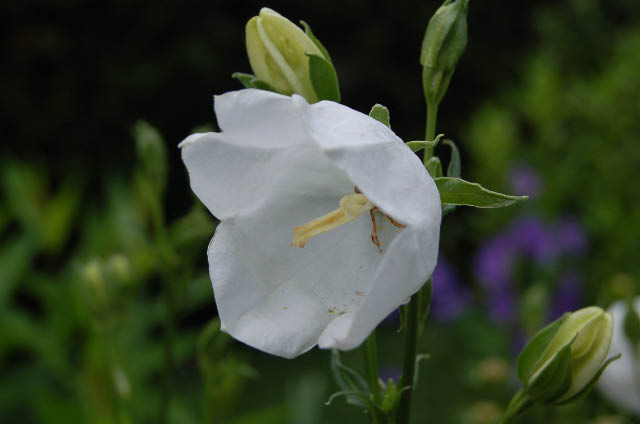
Plants currently in my garden.
This is a very long list of perennials which grace the various
garden beds on my property. For each plant a description, growing
conditions and some personal observations on how it grows in my gardens
is provided, along with some technical information (if available) and
photos.
The perennials are listed in alphabetical order by their common name.
- Allium (Onion) "Purple sensation" –
Allium "Purple sensation."
- Description: Late-Spring blooming member of the onion family
produces spiked leaves about 6-8 inches (2-3 cm) long which cascade to
the ground. Once developed fully, a long flower stem grows 20-36 inches
(7.5-13 cm) upon which forms a large (3 in / 1.2 cm) spiked ball which
produces tiny, star-shaped purple flowers at the end of each tiny spike
(see photo below). The tiny blooms last several days before producing
seed which remains attractive as small knobs on tiny spikes. The
foliage begins to die off before the blooms are open and is completely
gone shortly after the blooms turn to seed. An elegant presentation in
beds and borders, and ideal for dried arrangements.
- Growing preferences: Full sun. Blubs are planted about 6
inches (2 cm) deep in well drained soil.
- Observations: Began with five bulbs which bloomed faithfully
for several years before beginning to produce small corms and
eventually many additional blooms. In 2008, dug up all the bulbs,
replanted the 9 largest in the original location, put three in the
front garden, and gave away the numerous small bulbs and cormlets. By
2010, the nine bulbs had already produced many others. Its habit of
dieing off completely after blooming (usually by mid-June) makes it
ideal for combining with later growing plants. (I combine mine with
Blazing Star which grows later.) In the front garden, I use it with the
lupin. By 2013, the main group had 14 or more blooms and will be ready
for thinning again. However, in 2014, after a particular;ly hard
winter, only 8 blooms were produced in the back garden and the front
ones failed to appear.
- Zone: 4-9.
- Year added: Mid-1990's.
- Plant source: Garden centre.
- Links to further info:
- Photo(s):




 (Top)
(Top)
- Balloon flower – Platycodon
grandiflorus ‘Fuji Blue'.
- Description: Seed strain from Japan with balloon-like
buds that open to deep blue flowers. Late to emerge in spring.
Excellent cut flower. Height 20" (50cm) with 24" (60cm) spacing.
Flowers July-August.
- Growing preferences: Full sun to partial shade.
- Observations: I really liked this plant. The blooms are
very attractive and interesting to watch as they develop and open. It
is late to appear in spring to the point of thinking the plant may have
died over the winter. Each year the plant produces more stalks of
flowers. The stalks are so tall some staking is required to provide
required support. In 2008, due to the amount of rain in June, the plant
grew taller than usual with several new bloom spikes. It was
transplanted in 2008 to the far west back garden with the taller plants
and continued to thrive for a couple of years. Then, in the fall of
2011, the rhizome went mushy and it died. I obtained a transplant from
a neighbour two doors away and planted it in the same garden, but in a
different spot. Unfortunately, it suffered the same fate. I should have
planted it far away from the original. I hope to obtain another
transplant sometime in the future.
- Zone: Hardy 3-8.
- Year added: Original 2005; latest 2012.
- Plant source: From another's garden.
- Links to further info:
- Photo(s): Flower close-up


 (Top)
(Top)
- Bellflower – Campanula Grandiflora Alba
§.
- Bethlehem sage (lungwort) – Pulmonaria
saccharata.
- Description: An evergreen perennial with roundly oval,
white-spotted leaves up to 11 inches long. It has a clump forming
growth habit and is rhizomatous. Dainty drooping clusters of small
flowers in mid
to late spring. Flowers develop with pink colour but turn to blue. Stem
leaves are nearly as large as base leaves. Often valued more for
leaves, which are white-spotted, that remain
attractive all season. Forms a rounded plant 12" (30cm) or more in
circumfrence. Plants spread quite rapidly but they need to be divided
only when the vigour wanes. Makes an excellent ground cover or border
plant.
- Growing preferences: Grow where soil will remain moist and
cool. Full sun to part shade. Divide every 3 to 5 years. Remove old
leaves after flowering. Divide plants in late summer. Water well after
dividing.
- Observations: Plants spread quite rapidly. Divide plants in
late summer only when vigour wanes. Water well after dividing. Makes
excellent ground cover or border plant. In 2009 I planted this specimen
in the south
garden beside the house. The plant did well in 2010, blooming early and
for a long time, and growing considerably in size. However, the hot,
sunny location caused the plant to wilt badly by noon, but it recovered
in the evening. In 2012, I moved the plant to the front garden
(north-facing) and split it in two pieces. It is thriving. The profuse
early-spring blooms are very appreciated. In 2014, I thinned the plants
as they were crowding other plants. In 2016 they were exceptionally
robust.
- Zone:
- Year added: May 2009.
- Plant source: Cindy Bickerton's plant exchange.
- Links to further info:
- Photo(s):



(Top)
- Canada Violet – Viola canadensis.
- Description: Grows to a mound 14 inches tall with a 12 inch
spread. Cheery white flowers that have a tinge of violet bloom all
spring. Well behaved, clump forming habit. This species naturally grows
in fertile Ontario woodlands.
- Growing preferences: Part sun to shade in almost any soil but
preferably moist.
- Observations: Just as this newly planted addition to the
garden was ready to bloom it was partially dug up and eaten by a
squirrel. I managed to salvage the plant and it appeared in 2007. It
continued to self-seed little plants resulting in giving some away in
early 2012. However, the drought of that summer took a toll and only a
very small plant survived to grow in 2013. Two good-sized plants
appeared in 2014 under the ilac bush and flowered nicely. Despite the
description of this plant, I have never got anything larger than about
4 inch spread and about 2 inches tall.
- Zone:
- Year added: 2006 (June).
- Plant source: Fletcher Wildlife Garden plant sale.
- Links to further info:
- Photo(s):

(Top)
- Candytuft – Iberis.
- Description:
A spreading perennial with narrow evergreen leaves. Umbels of
long-lasting white flowers first appear in late spring (May). Iberis
sempervirens (edging or evergreen candytuft) has a height of 30cm / 12"
and spread 60cm / 24". Full to part sun. Good for borders or retaining
walls.
- Observations: Placed this in two different locations to
determine growing performance. One had more sun than the other. Both
bloomed prolifically.
- Zone:
- Year added: 2017.
- Plant source: My son's garden.
- Links to further info:
- Photo(s):


(Top)
- Coreopsis 'Sunburst' – Tickseed
'Sunburst'.
- Description: Rich golden-yellow, single-petalled, abundant,
daisy-shaped flowers. Remove dead flowers to encourage further bloom.
Propagate from seed or by division every two to four years in the
spring. Space plants 1-1.5 feet apart. Spreads readily. Blooms
continuously from June to frost. 24-30".
- Growing preferences: Thrives in well-drained, sunny location.
- Observations:
Not invasive. If old blooms are taken off the
self-seeding will not take place. Flowers are great for bouquets or
fresh flower displays as the flower stems are very long and the blooms
last a long time. In 2020 I almost lost the plant. It shrunk to a tiny
sprig without flowers perhaps due to a neighbouring plant (Bellflower)
fighting it. I gave the plant more space and by 2023 it was back to its
robust glory and bloomed for most of the summer and into October.
- Zone: 4-10.
- Year added: Early 1990's.
- Plant source: Obtained from my Mother's garden where it
self-seeded readily.
- Links to further info:
- Photo(s):

(Top)
- Coreopsis 'Sunfire' – Tickseed 'Sunfire'.
- Description: Rich red, single-petalled, abundant,
daisy-shaped flowers. Remove dead flowers to encourage further bloom.
Propagate from seed or by division every two to four years in the
spring. Space plants 1-1.5 feet apart. Spreads readily. Blooms
continuously from June to frost. 24-30".
- Growing preferences: Thrives in well-drained, sunny location.
- Observations:
I started several of these plants from the
seeds provided to me in 2012. They became well established and I left
three in a planter and two others were placed in the garden. Over the
winter of 2012, the planter was buried in the dormant vegetable garden.
The spring of 2013 revealed that one of the transplants had died, but
the second was doing very well and the three in the planter were
robust. They bloomed profusely. The harsh winter of 2013-2014 killed
off all the plants however. Small self-seeded seedlings sprang up in
several places where the plants were located. Each year a couple of
these plants are nurtured into full size and the cycle repeats.
- Zone: 4-10.
- Year added: 2012.
- Plant source: Obtained seeds from another gardener.
- Links to further info:
- Photo(s):


(Top)
- Creeping Thyme 'Pink Ripple' – Thymus 'Pink
Ripple''.
- Description: This is a lemon-scented selection forming a low
mat of tiny light green leaves, with clusters of salmon-pink flowers in
early summer. Most commonly used as a fragrant ground cover or edging
plant, growing happily in any sunny garden. Also excellent in pots.
Makes a unique lawn substitute. Evergreen. Height 4 - 6" / 10-15 cm;
spread 1-2' / 30-60 cm.
- Growing preferences: Average to dry, well-drained soil.
- Observations: This is a wonderful ground cover that spreads
rapidly once established. The carpet of pink flowers in June are very
striking and eye-catching.
- Zone: 4-9.
- Year added: 2010.
- Plant source: Obtained from Cindy Bickerton plant exchange.
- Links to further info:
- Photo(s):


(Top)
- Crocus – Crocus.
- Description:
- Growing preferences:
- Observations: There are two varieties spread about the
gardens. Most prolific are the tiny blooms of purple and yellow. There
are a couple of placements of a larger purple bloom variety. Both bloom
early in the spring, even before their snow cover has dissipated. The
squirrels are also assisting in their spread into other areas. I try to
inter-plant the bulbs with other plants if possible as the foliage
takes a long time to die back.
- Zone:
- Year added: Early 1990's.
- Plant source: Packaged bulbs purchased from nursery or garden
centre.
- Links to further info:
- Photo(s):


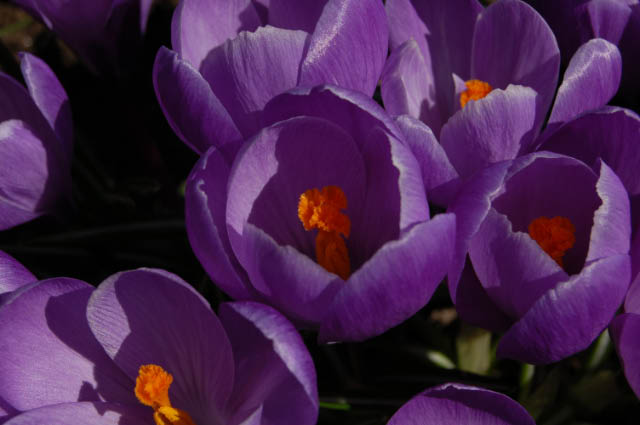

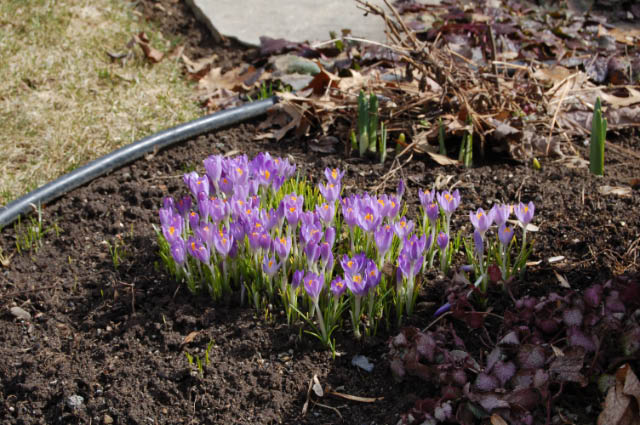
(Top)
- Daffodil – Narcissus.
- Description: Good sized pure yellow blooms appear on sturdy
18" stalks in early spring.
- Growing preferences: Full sun, especially in early spring.
- Observations: This particular bulb reproduces rapidly and in
great quantity. I started with about a dozen bulbs and now I have at
least 75 or more, and this is after giving many of them away. Some
bulbs fail to flower in a particular year and generally do not flower
again, despite producing ample foliage. Main complaint is that the
plant foliage does not die back until July when the leaves may be
pulled out of the ground with a light tug. Thus, allowance must be made
for surrounding plantings which take the presence of the foliage into
account. Bulbs have been put in around trees and bushes, in between
peonies and in the back of gardens where later growth will block the
view of the foliage until it dies off. The harsh winters of 2013-2014
and 2017-2018 resulted in some bulbs not blooming while others
continued to thrive
and reproduce.
- Zone:
- Year added: Early 1990's.
- Plant source: Bulbs purchased from a nursery.
- Links to further info:
- Photo(s):




(Top)
- Daylily – Hemerocallis.
- Description: Bold trumpet-shaped flower from 1 to 10 inches
across, sometimes with double row of petals or ruffled edges in spring,
summer or fall. Clusters of up to 30 flowers grow on stiff 1- to 7-foot
stems rising from attractive clump of narrow, arching leaves. The long
flower buds open successively, and each flower lasts only a day.
- Growing preferences: Full sun.
- Observations: Siloam
Red Ruby: I first planted this specimen under the lilac
tree on the west side of the house. The leaves came the next year
(2006) but no blooms. I moved the plant to the far west garden and it
bloomed in 2007. The plant continues to do well. It was split in 2017
as it had become too large for its space.
- Zone: 3-10.
- Year added: 2005 through the Central Park plant exchange.
- Plant source:
- Links to further info:
- Photo(s):



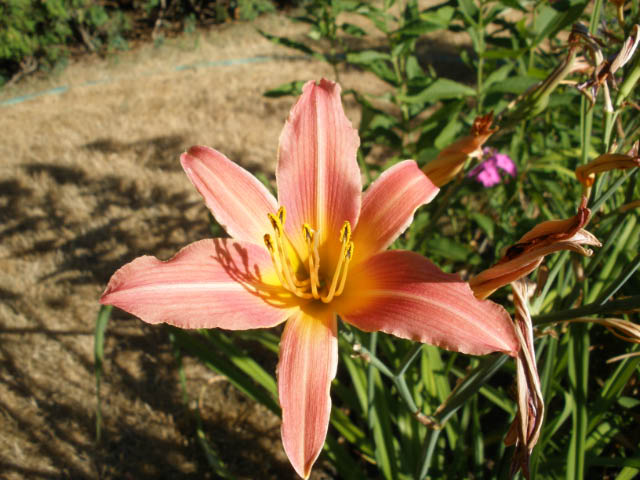


(Top)
- Dense Blazing Star – Liatris spicata
‘Kobold'.
- Description: A dwarf form of the common Blazing Star, making
it better suited for most gardens. Butterfly-attracting spikes of
purple-mauve flowers which bloom July - September. Height to 20".
- Growing preferences: Requires full sun. Spaced 18" apart.
- Observations: Each year this plant expands in size in all
directions. The foliage is very dense (as per its name) and lacy, thus
attractive. The 6" bloom spikes open from the top to the bottom. Even
after the flower loses its colour, the remaining spike is attractive
and provides a focal point. Some sections were given away in 2013 to
thin the ranks.
- Zone: 3-9
- Year added: June 2005.
- Plant source: Fletcher Wildlife Garden plant sale.
- Links to further info:
- Photo(s):



(Top)
-
Fall crocus – Colchicum.
- Description:
A very cute little bulb flower that blooms from the beginning of fall
up to the first frost spells. Plant bulbs 4-6" (10-20cm) deep in
clusters.
- Growing preferences: Full sun to light shade. Grows in just about any soil.
- Observations: .
- Zone:
- Year added: 2023.
- Plant source: Local gardener.
- Links to further info: www.nature-and-garden.com/gardening/colchicum.html
- Photo(s):
(Top)
- Field Violet – Viola arvensis Murr. (aka
field
pansy, wild pansy, Johnny-jump-ups, European field pansy or
hearts-ease).
- Description: Field violet essentially resembles a miniature
pansy. The cotyledons are partially round and oval with a short stem.
The leaves have notched margins and are ovate-lanceolate (oval and
long, tapering to the leaf tip). The flower contains five petals that
are light yellow, whitish and pink to violet. Reproducing only by seed.
One plant will generate around 2500 seeds. Field violet will flower and
its seed will germinate all year round and ideally at a depth 0.5 to 1
cm. Flowers from early May to August. May flower later in the fall.
Annual or winter annual.
- Growing preferences: Grows in just about any soil and light
conditions.
- Observations:
While some people (especially farmers) consider this an invasive
plant, I have found it to be an attractive and easy to control addition
to the garden. As the plant ages it may get a bit gangly and needs to
be cut back or pulled out. Not to worry, soon new plants will show up
and produce their attractive pansy blooms in short order. This is one
of the first plants to bloom in the spring and the bright colours are
most appreciated. The harsh winter of 2013-2014 and a thorough tilling
of the gardens in the spring resulted in the near total elimination of
the plant, although a few did survive and bloomed. The harsh winter of
2017-2018 did the same thing, but the seeds germinated eventually.
- Zone:
- Year added: Unknown.
- Plant source: Unknown.
- Links to further info: www.omafra.gov.on.ca/english/crops/field/weeds/field_violet.htm
- Photo(s):


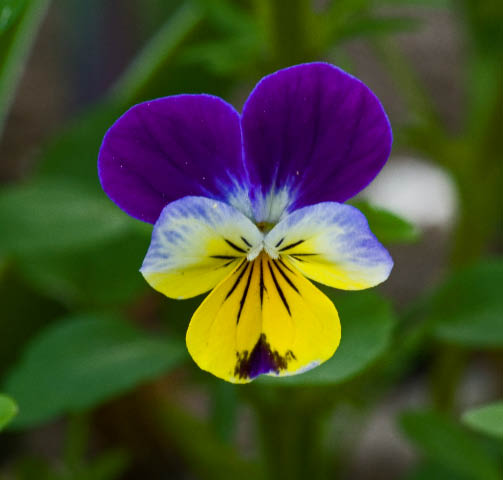
(Top)
- Geranium or cranesbill – Geranium.
- Description:
- Growing preferences:
- Observations: Geranium
(annual): Garden includes red and pink varieties which
are usually over-wintered in the house. Cuttings are made in late
winter and rooted for spring planting once the soil has warmed.
However, after many years of doing thins, in 2012 the plants were left
outside at the end of the season and new plants were acquired in the
spring of 2013. There are red, mauve and pink plants. The cycle of
bringing them inside and making cuttings continued in 2014 through
2018. Cranesbill:
This perennial produces an attactive mauve flower starting in May. It
spreads slowly, but determinedly through underground runners.
- Zone: Geranium: Not winter hardy. Cranesbill:
- Year added: 2013.
- Plant source: Garden centre.
- Links to further info:
- Photo(s): Cranesbill

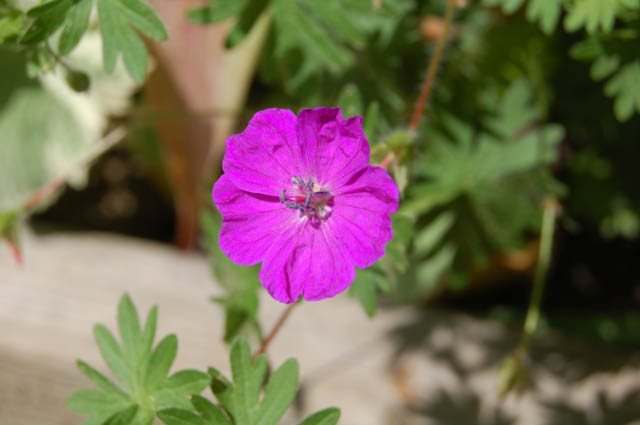
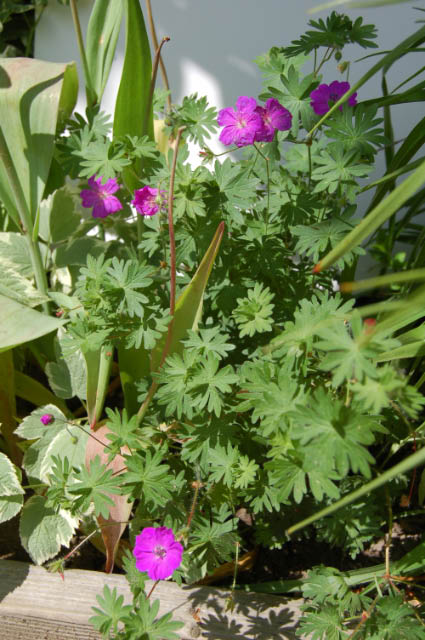
(Top)
- Harebell – Campanula rotundifolia.
- Description: This species naturally grows in Ontario in rocky
places, crevices and along sandy shores. Grows up to 20 inches tall
with a 12 inch spread. Blue flowers bloom all summer.
- Growing preferences: Part to full sun in sandy or rocky soil.
- Observations: I find this plants in my garden gets rather
gangly and needs support on the tall flower stems. It never gets very
large, even after many years. This is probably because it is not being
grown in its preferred conditions.
- Zone:
- Year added: June 2006.
- Plant source: Fletcher Wildlife Garden plant sale.
- Links to further info:
- Photo(s):

(Top)
- Henbit Deadnettle – Lamium amplexicaule.
- Description: A low-growing annual plant growing to 10-25 cm
tall, with soft, finely hairy stems. The leaves are oval, gray-green to
silvery-white with greenish margins, opposite, rounded, 2-3 cm
diameter, with a lobed margin. The flowers are pink to purple, hooded,
½-1" long flowers, in whorls on short spikes above foliage, late spring
to early summer (May to July). It flowers very early in the spring even
in northern areas. It propagates freely by seed and is regarded as a
minor weed. Where common, is an important nectar and pollen plant for
bees, especially honeybees, where it helps start the spring buildup.
Lamium is a genus of about 40-50 species of flowering plants in the
family Lamiaceae (mint), of which family it is the type genus. They are
all herbaceous plants native to Europe, Asia, and north Africa, but
several have become very successful weeds of crop fields and are now
widely naturalised across the temperate world. The genus includes both
annual and perennial species; they spread by both seeds and stems
rooting as they grow along the ground. The common name refers to their
superficial resemblance to the unrelated stinging nettles, but unlike
those, they do not have stinging hairs and so are harmless or
apparently "dead". It is widely naturalised in eastern North America
and elsewhere, where it is often considered to be an invasive weed.
They often have invasive habits and need plenty of room. Propagate from
seed or by division in early spring.
- Growing preferences: Frost hardy and grows well in most
soils. Prefers full sun. Plant in the spring.
- Observations: The plant is easily kept in check by trimming
extremities and digging out the branches which have rooted in the top
half-inch (12 mm) of soil. The leaves are very attractive although the
slugs do their damage later in the season and ruin the overall look.
- Zone: 3-8.
- Year added: Early 2000's.
- Plant source: Neighbour's plant sale.
- Links to further info:
- Photo(s):
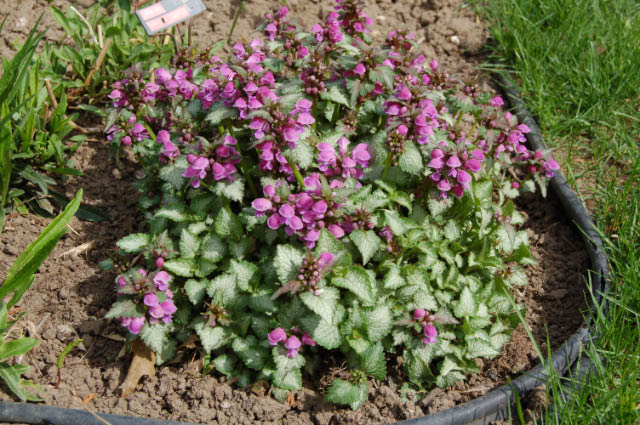


(Top)
- Iris – Iris.
- Description: The garden now contains several varieties and
colours of iris, and the numbers continue to expand. Tall bearded: The gardens
contain two heights of these with appropriately sized blooms. Clumps of
stiff, narrow, sword-like leaves and
upright stalks of spring blooms. Flowers are composed of erect petals
(standards) and drooping petals (falls). Blue, gold (brown) and yellow.
Fan-shaped foliage with 60-75 cm /24-30" and 90-100cm / 36-40" spikes
supporting several blooms in May.
Plant rhizomes level with soil surface. Propagate by division after
flowers fade. Siberian iris
(Iris sibirica):
This is an attractive version of iris with tiny, beautiful purple
flowers in early summer. They do not tolerate strong competition. They
are well-behaved and spread very slowly. They grow in a small mound or
grouping. They survive cold weather especially well. Minature dwarf iris:
This 25cm /10" tall hybrid has a tiny purple bearded flower which
appears in May usually. The flowers are short-lived unfortunately. The
tubers spread readily, thus they are now in three different gardens and
have been passed on to others.
- Growing preferences: Moist, well-drained soil in full sun.
- Observations: These tubers spread quite readily and I have
found it necessary to dig up sections every year to thin the growth.
The plants require little care, although weeds are difficult extract
from around the tubers after the first year of growth. The foliage
provides a good backdrop to later blooming plants or annuals.
- Zone: 3-10.
- Year
added: The shorter tall beared have been in the garden since before we
moved
into the house in 1973. The larger tall variety was added in the
2010-2013 period. The Siberian plants were added in approximately 2013
and the dwarf variety in 2014.
- Plant source: Plant exchanges.
- Links to further info:
- Photo(s):






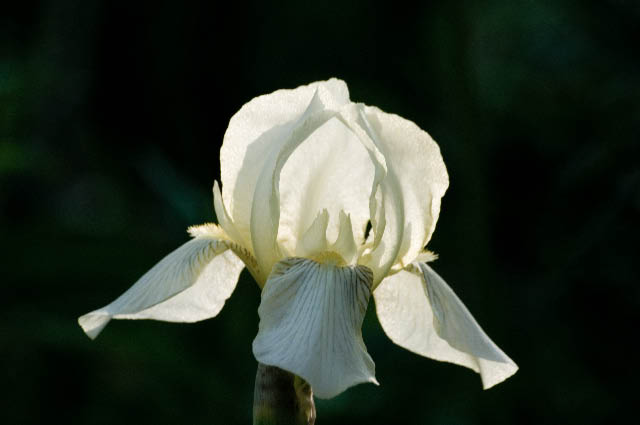
(Top)
- Lupin – Luplinus.
- Description:
Towering spikes of pea-like flowers above deeply divided leaves. Bloom
in late May to early June. Height 18-36" / 45-90 cm; space
8-18" / 15-45 cm.
- Growing preferences: Full sun, with moist soil.
- Observations:
I have had varying success with lupins. In 2016-2017, the "Popsicle
Red" I had grown for several years, died out. Luckily, I picked up a
beautiful mauve variety in 2016 that is currently blooming
proflifically. In 2018, a new pink plant was added to the front garden,
though well away from where the red one died off. They
need a lot of water or the foliage and flowers will droop. They quickly
recover when watered.
- Zone: 4.
- Year added: 2016 and 2018
- Plant source: Garden centre.
- Links to further info:
- Photo(s):





(Top)
- Mountain bluet - Centaurea montana
(Mountain Cornflower or Perennial Cornflower).
- Description: "Centaurea is a composite or member of the daisy
family. C. montana is the best known of the perennial species and it is
known by several common names, Mountain Bluet, Perennial Bachelor
Buttons, and even Perennial Cornflower. Cornflower by the way comes
because this plant naturalizes quite nicely around cultivated corn
fields. Bachelor Buttons comes to us from either the habit of bachelors
wearing the flowers (it lasts a long time as a cut flower) in button
holes or as a reference to the starburst medals worn by soldiers (who
were sometimes bachelors too)."
- Growing preferences: Full sun.
- Observations: The plant spreads readily just below the ground
but is easy to control. After flowering the first time in June, the
foliage often dies off or turns brown and unattractive. I cut it back
to the ground, removing all traces of foliage. The plant regenerates
and blooms again in the fall. Before winter, I remove all remaining
foliage and clear any weeds. Even though this is not a favourite plant
of mine, just about every female that sees it in bloom loves it. Thus,
it has found its way from my garden to many others.
- Zone:
- Year added: Unknown.
- Plant source: Unknown.
- Links to further info: www.gardening-tips-perennials.com/mountainbluet.html
- Photo(s):
(Top)
- Nodding wild onion - Allium cernuum.
- Description: Grows 14 inches tall with a 12 inch spread.
Attractive foliage with clusters of drooping pink flowers in summer. A
good nectar plant for insects. Native to Southern Ontario woodlands and
rocky outcrops.
- Growing preferences: Part to full sun in well-drained soil.
- Observations: I love the slender leaves of this plant and its
tight growth. The flowers are cute and truly hang their heads on the
ends of the slender stalks. It spreads slowly.
- Zone:
- Year added: Probably June 2005.
- Plant source: Fletcher Wildlife Garden plant sale.
- Links to further info:
- Photo(s):
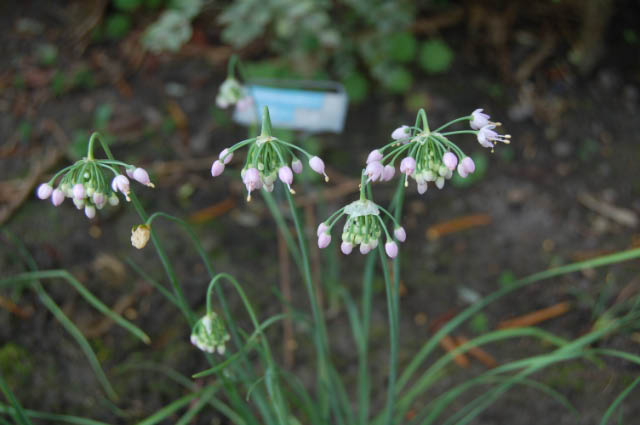



(Top)
- Painters pallett (palate) – Persicaria.
- Description: aka knotweed. An herbaceous perennial which
produces tiny red bead flowers on a long spike in late summer.
Primarily a foliage plant due to its multi-coloured leaves.
- Growing preferences: Sun or part shade. Mine is in full sun and
increases a bit in size each year. It has reached about 25" or 10cm in
height. The photo included was taken in June 2018.
- Observations:
- Zone: 4-8.
- Year added: 2014 perhaps.
- Plant source: Community plant sale.
- Links to further info:
- Photo(s):

(Top)
- Peacock Orchid – Abyssinian Gladiolus –
Acidanthera bicolor.
- Description: Native to Ethiopia, these plants are close
relatives of gladioluses. They grow from corms, sending up tall spikes
that bear delightfully scented, creamy white flowers that open in
sequence from the bottom of each spike. Plants are highly effective
grouped in clusters of a dozen or so in borders, or close to the house
where their fragrance is particularly welcome. They also make splendid
cut flowers. A. bicolour murielae, the most common acidanthera in
cultivation, grows 2 1/2 to 3 1/2 feet tall and has flowers up to 4
inches across, with red to purple centre markings. Removing faded
flowers encourages the spikes to branch, giving more blossoms and
extending the flowering season. Since they require a long growing
season, it is advisable (though not essential) from Zone 6 north to
plant the corms indoors in pots or in a cold frame about a month before
the arrival of 10°C to 15°C nights. Transfer the plants to the garden
without breaking the soil balls. Corms can also be planted in tubs so
that the plants can be moved into a protected area at night if frost
arrives before flowering stops. When the leaves have turned brown in
fall or before the first hard frost, dig up the corms, shake off the
soil – being careful to save the cormels – and let them dry for a few
days in an airy place out of the sun. Cut the tops back to 2 inches
from the corms and pull off the dried remains of the previous season's
corms. Store them over the winter in a cool basement area wrapped in
several layers of newspaper, in dry peat moss, perlite or vermiculite.
Propagate from the small corms and cormels that develop at the base of
the large corms. Plant the cormels separately in rich soil; they
require at least two growing seasons to reach flowering size. (Ref: see
link below.)
- Growing preferences: Full sun, neutral, well-drained soil
- Observations: I first planted the bulbs in the full sun in
the west patio garden. I found they were often not able to produce
blooms before the first frost. I moved them to their own garden along
the east side of the house where they seemed to do much better. They
bloom in August or early September. Width: .5 ft.; height: 2 - 3 ft. I
am not sure why, but some bulbs fail to bloom some years and do not do
so therafter. I have nutured some of the tiny corms in a small planter
and after two or three years they begin to bloom. I hope to use them to
replace the older, non-performing bulbs which have been thrown away.
- Zone: 6 - 11.
- Year added: Mid-1990's.
- Plant source: From a neighbour's (Hannie Fitzgerald) garden.
- Links to further info: http://www.sd1new.net/GardenPages/peacock_orchid.htm
- Photo(s):

(Top)
- Peony – Paeonia.
- Description: The peony's claim to fame is longevity, with
plants documented to have lived for 50 to 70 years. A mature plant will
usually take up a three foot space and produce a large number of
blooms. Care requirements are minimal. After flowering and until the
first fall freeze, the deep green foliage can make a lovely backdrop
for other colourful flowers or plants. Bloom from May to June. 18-30"
high. Large, fragrant blooms. Foliage dark glossy green turning to
bronze in autumn.
- Growing preferences: Half to full day sun, good friable, well
drained soil, air circulation around the plant, and a cold winter
dormancy period. Fall is the correct time for planting bare roots
giving them a chance to become established before bloom time.
- Observations: I have eight of these gorgeous plants: double
white (2), single light pink (2), single mauve (3), and double deep
red. While these plants may remain in the same place for decades, I
usually try to dig mine up and split them up every ten years or so. It
is a major undertaking suited for late August or early September. Their
tubers are easily broken as they are very soft. Extracting the
individual tubers is very difficult as they are intertwined. I find it
best to dig a large trench around the plant and remove all the tubers
from the hole before attempting the split. I take careful note of their
depth which is marked on the outside of the stalks near the ground.
Peonies are very particular as to how deep they are planted. Plant
peonies with their "eyes" (red or white nubs at the base of the plant)
1-2 inches below the soil's surface to ensure blooming. It may take 2
or more years for the plant to become established enough to produce
blooms. You should expect to leave the peony for 10-15 years before
lifting and splitting the roots. I try to give the plants a feed of
compost at least once each year. The four plants against the south side
of the house always bloom much ahead of those in most gardens. I always
hear from visitors or recipients of bouquets, "Your peonies are in
bloom already!?" In 2012, I split one of the white ones by the house
and it bloomed in 2013. In August of 2013, I split the other three by
the house and one other light pink (a lot of work!) and was pelased to
see all bloomed in 2014 (although the single mauve only had two blooms.
he white seem to be the most prolific bloomers.
- Zone:
- Year added: Most of the plants in my garden were already
there when I moved in in 1973.
- Plant source: Unknown for most, although the small red plant
was taken from a plant belonging to my Mother.
- Links to further info:
- Photo(s):




(Top)
- Phlox – Phlox.
- Description: Clusters of five-petalled flat-faced flowers on
erect stems. Very hardy plants that will grow quickly into 2-3' tall
clumps. Divide every three to four years to keep robust. Propagate by
division.
- Growing preferences: Full sun or part shade in moist,
well-drained soil rich in organic matter. Need lots of water in spring
and summer; air circulation after foliage forms due to susceptibility
to powdery mildew.
- Observations: My gardens contain the following colours:
salmon (Spitfire), lavender (Amethyst), white with red eye (Graf
Zepplin or pink eye) and white. In 2011, I added a red variety which is
very attractive. With the exception of the salmon colour, the other
grow well and spread rapidly. I usually split at least one or two
groups each year and give away the extra. The powdery mildew sets in
very early and can defoliate an entire plant stalk very quickly. I try
to control it by breaking up tight clumps (to provide air circulation)
and picking off diseased leaves as soon as possible. The blooms can
last a long time and provide a large swath of colour. Deadheading the
spent blooms encourages a subsequent, though smaller show of blooms.
- Zone: 3-10.
- Year added: The salmon, lavender, pink-eye and white plants
were on the property when I moved in in 1973. The red was added in 2011.
- Plant source: Unknown except the red which was transplanted
from a neighbour's garden.
- Links to further info:
- Photo(s):








(Top)
- Pincushion flower – Scabiosa.
- Description: Globular heads of flowers with protruding
stamens give
this plant its common name. Flowers from early sdummer to fall. Height
18-30 inches (45-75cm); spread 12 inches (30 cm).
- Growing preferences: Full sun or part shade in well-drained
to sandy soil, slightly alkaline.
- Observations: Keep flowers cut to prolong bloom. Divide as
needed to maintain vigour. May require staking (or use a tomato cage).
Divide plants in the spring or plant seeds in the summer.
- Zone:
- Year added: 2015.
- Plant source: Carlington plant sale from unknown gardener.
- Links to further info:
- Photo(s):
(Top)
- Scottish bluebells - Campanula
rotundiflora (harebell).
- Description: Delicate bright blue-violet inch-wide flowers
grow in profusion at the tips of wiry 12-24 inch stems from late spring
through late summer. Clip faded flowers to encourage further bloom.
- Growing preferences: Sun or shade in almost any soil.
- Observations: These plants look better when planted in a
tight group. In this way, the tall stalks support one another and the
profusion of colourful blooms is most striking. Cutting the faded
blooms or the stalks releases a white, milky liquid that is very sticky
and hard to remove from hands, tools or clothes. Second and subsequent
blooms come from just below their predecessor so care must be taken in
pruning spent blooms.
- Zone: 3-9.
- Year added: Unknown.
- Plant source: Probably arrived as wind blown seeds or from
bird droppings.
- Links to further info:
- Photo(s):

(Top)
- Sedum – Stonecrop spectabile.
- Description:
My gardens hosts three varietes of this durable, attractive plant. (1)
Autumn Joy (photos 1 and 4 below) is a succulent with fleshy soft
leaves and stems with large
clusters of
small red flowers in late summer or early fall until frost. Attractive
even
when not in bloom. Rich nectar attracts butterflies and bees. Divide in
spring (even small rootless pieces take root quickly). Division
necessary only to maintain good flowering. Height 16 " / 40 cm; spread
12-16" / 30-40 cm. (2) A low-growing sedum used as ground cover (photo
2 below). It blooms with small, bright yellow flowers in late June or
July. Spreads slowly. (3) Another slow spreading ground cover with
attractive reddish stems.
- Growing preferences: Poor soil, dry, sunny.
- Observations:
- Zone:
- Year added: 2010?
- Plant source: Neighbour's garden.
- Links to further info:
- Photo(s):




(Top)
- Shasta Daisy - Alaska – Leucanthemum.
- Description: White with yellow centre suitable for cutting.
Blooms June to July.
Blooms last 2-3 weeks. 2-3'. Very hardy.
- Growing preferences: Full sun.
- Observations: The flowers are a favourite of earwigs. They
grow quite well, except for the occasional year when winter conditions
may destroy many plants. This is why I have created another planting in
the front garden (as a backup). The blooms last for a long time and
make good cuttings. When the flowering has ended, I cut back the
foliage to the ground as it withers and turns brown, making it
unattractive
- Zone:
- Year added: Unknown.
- Plant source: Unknown. I believe it may have been in the yard
when we moved in in 1973.
- Links to further info:
- Photo(s):

(Top)
- Spiderwort - Tradescantia.
- Description: Clusters of purple, three-petalled flowers on 2
foot stems rising from clumps of long, narrow strap-like leaves.
Individual flowers last only a day but open in succession for
continuous late-spring or early summer bloom. If foliage becomes messy
and is cut to the ground after flowering, the plants will send up fresh
foliage. Propagate by division in spring.
- Growing preferences: Grow well in light shade and a moist,
well-drained soil enriched with organic matter. Can also tolerate full
sun.
- Observations:
This plant has been in the same spot (under the west lilac tree) for a
long time and continues to do well. It has been split up many times to
control its size. It is a frequent give-away. It also self-seeds very
readily and the seedlings are easy to transplant or pot for giving
away. In 2012, I put it in a container buried in the ground to try to
control its spread. Based on the performance in 2013, I would say it
does not like this arrangement as it did not bloom well and died back
early. In the fall of 2014, I removed the container and it is back to
blooming nicely.
- Zone: 4-9.
- Year added: Late 1980's ?
- Plant source: Unknown.
- Links to further info:
- Photo(s):



(Top)
- Sundrops – Oenothera.
- Description: Showy, four-petalled, large lemon-yellow flowers
grow up 1-2" across in clusters at tops of 18-24" stems. Blooms June to
July. Spreads readily. Propagate by division in spring or from seed.
- Growing preferences: Sun to half-shade. Needs moisture in
summer or will wilt badly.
- Observations: These plants spread incredibly well wherever I
have them planted. I usually give away large clumps each spring. They
are easy to dig up as the runners are just below the surface. They
transplant well. The yellow flowers make a wonderful showing by
producing a carpet effect. The amount of light and moisture affect the
height of the plant.
- Zone: 4-8.
- Year added: The plants were on the property when I moved in
in 1973.
- Plant source: Unknown.
- Links to further info:
- Photo(s):



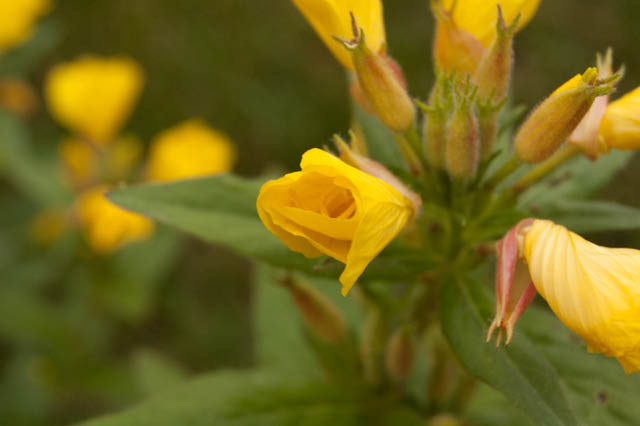

(Top)
- Tulips – Tulipa.
- Description: There are many varieties in the garden. Most
predominant are purple, red and yellow (with peony-like blooms). There
are some gorgeous red/yellow blooms as well as regular yellow.
- Growing preferences: Sun.
- Observations: Between the squirrels and the harsh
winter conditions in 2012-2013, a great number of the bulbs
died/disappeared. The squirrels are particularly troublesome as
starting in 2011 they chew off the blooms. In 2014, over 20 flowers
suffered this fate, and this was repeated in 2015 with 25-30 blooms
lost. I have to resort to wrapping groups in chicken wire or covering
them with bird netting to protect them. Red is their favourite colour.
The red-yellow blooms are late-spring, huge and long-lasting. The
winter of 2014-2015 was hard on some of the bulbs and they did not
bloom.
- Zone:
- Year added: 2012, 2014 saw about 70 bulbs planted.
- Plant source: Some are descendents of bulbs which were on the
property in 1973 when I arrived. Others were purchased at stores or
nurseries. I obtained some in 2007 from a landscaper. In 2012 and 2014,
groups were obtained from the NCC through the Carlington Community
Association as part of a community beautification project.
- Links to further info:
- Photo(s):
(Top)
- Turtlehead – Chelone glabra.
- Description: Grows up to 30 inches tall with an 18 inch
spread. White snapdragon-like flowers in late summer. This species
grows naturally along Ontario stream banks and in wet woods and meadows.
- Growing preferences: Full sun to half shade in moist, humus
rich soil.
- Observations: It took several years before I got this plant
bloom. It is presently in the back lilac garden under the bird bath
where I hope it gets more frequent watering. It first bloomed in 2011
(?), and has continued to do so. It has begun to expand slowly. I
divided a couple of sections in 2015 to give away.
- Zone:
- Year added: June 2006.
- Plant source: Fletcher Wildlife Garden plant sale.
- Links to further info:
- Photo(s):
(Top)
- Veronica or speedwell – Veronica Sunny
Border Blue.
- Description: A carpeting perennial with green foliage and deep
blue-purple tall flower spikes of closely set, small flowers which
arise in early summer and continue throughout the summer. As the first
blooms fade, deadhead regularly for continuous flowering. Spread is
30-45cm and height is 8-20cm. Stake as needed.
- Growing preferences: Sun or partial shade. Well drained to
sandy soil. Water in dry weather.
- Observations: Divide when plants no longer bloom well.
- Plant source: Community plant sale.
Welcome | About Me | Interests | Feedback | Links
Date of last revision: 2023-10-07.
Material Copyright © 2023 David Darwin.






 (Top)
(Top)
